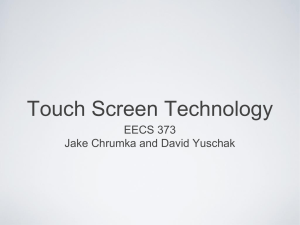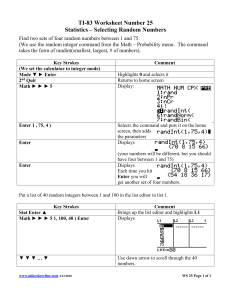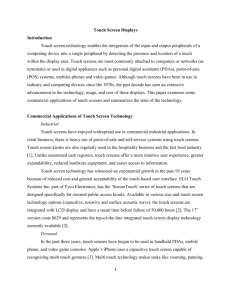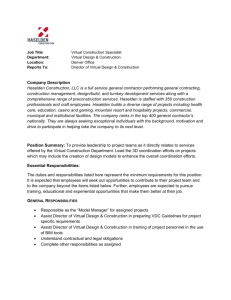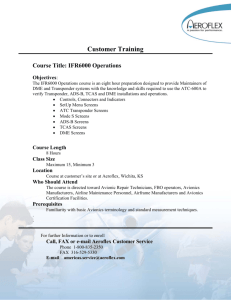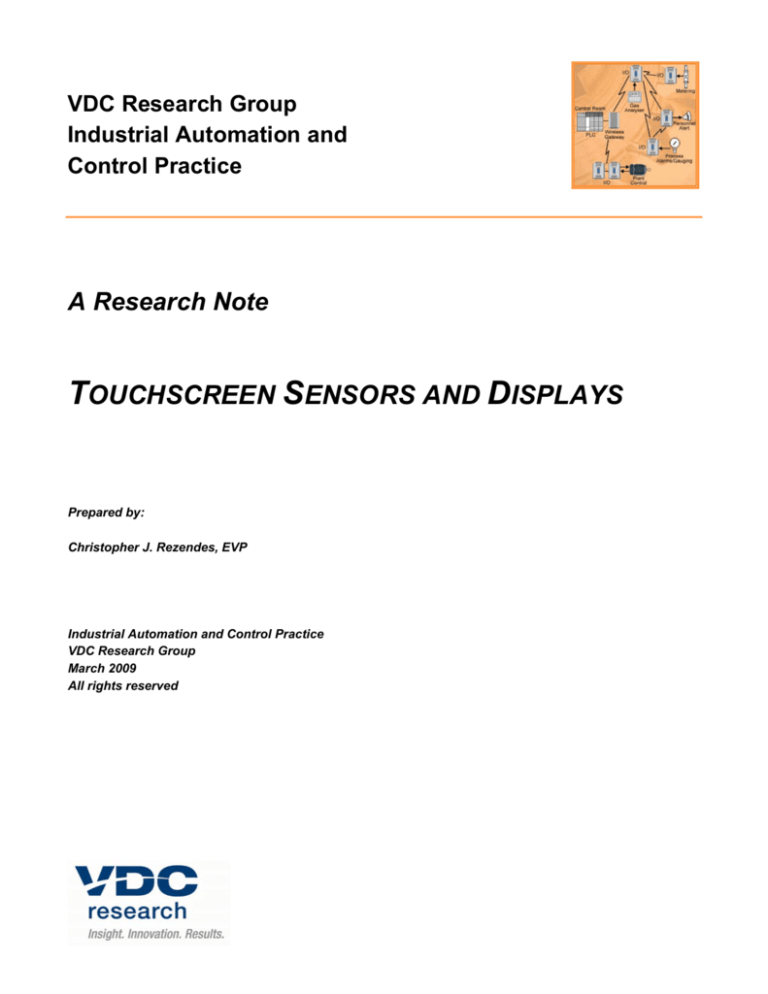
VDC Research Group
Industrial Automation and
Control Practice
A Research Note
TOUCHSCREEN SENSORS AND DISPLAYS
Prepared by:
Christopher J. Rezendes, EVP
Industrial Automation and Control Practice
VDC Research Group
March 2009
All rights reserved
A Research Note on, TOUCH SCREEN SENSORS AND DISPLAYS
1
The current IT investment environment may be the most cost-sensitive since the first commercial
deployment of the solid state transistor. And yet, demand for solutions with touch screens, which are
materially more expensive than traditional displays, are growing rapidly.
In a previous Research Note, VDC Research explored some of the highlights of touch screen market
acceptance and expansion generally.
In this note, we explore the features, functions and benefits that touch screen suppliers are offering that is
driving the continued market expansion, revenue growth and sustained profitability of these enabling
technologies.
To begin, it is important to consider that there is not one monolithic touch screen market, but a collection
of segments that are demanding touch technology:
•
4-wire resistive touch screen sensors have gained market share due to growth of smaller
touch screens in low-cost consumer applications (e.g., smart phones, PDAs).
•
5-wire resistive touch screens are more expensive than 4-wire, but have remained the
dominant resistive technology, due to advanced clarity and durability.
•
8-wire resistive touch screens continue to be used in high-end applications where increased
resolution over large displays is required.
•
Capacitive touch monitors are becoming more popular in harsh environments, due to high
optical quality, reliability, and watertight seals.
•
Emerging technologies such as optical imaging, virtual acoustic matrix, and dispersive signal
technology (DST) among others will be thoroughly investigated and their benefits and
drawbacks, along with the market implications in certain applications, will be analyzed.
So what might drive continued demand for touch, even during the recession?
•
Touch screens offer technical advantages and commercial value that few emerging
substitute technologies can match. Touch screens are displacing traditional keypads and
switches that are integrated into embedded computing and control functions. However, few
alternative technologies, such as projected interfaces and voice recognition, are displacing
the use of touch screens. Projected interfaces using holographic technologies are reserved
for niche markets and applications where mechanical switches are not rugged enough,
sterilization/ hygiene is important (medical devices), or user interfaces need to be bigger than
the device itself. Voice recognition has not yet emerged as a viable solution due primarily to
performance and workforce acceptance issues.
•
Development of new touch screen sensor technologies has been slow – but that could
change soon. Resistive and capacitive touch screen sensor technologies remain the most
popular solutions, even though their enabling technologies have remained unchanged.
However, updated technical solutions have recently emerged: Optical imaging, which allows
for multi-touch capability and whole screen coverage - ideal for larger displays; Virtual
Acoustic Matrix, which combines both resistive and capacitive technology and enables multiactivation modes, very high accuracy, no membrane nor film and ideal for low powered/cheap
displays-large or small; and Dispersive Signal Technology (DST), which uses vibration waves
to stimulate touch in large format 40-inch flat screens.
© 2009 VDC Research Group, Inc.
A Research Note on, TOUCH SCREEN SENSORS AND DISPLAYS
•
R&D is focused on improving features and functionalities of touch screens in order to
meet demand in new high growth applications. Research and development is primarily
focused on making touch screens easier to use and more attractive for outdoor and rugged
applications. For example, 3M has developed gesture recognition based on its DST platform
allowing for image pinching, object rotation, expanding, zooming, and other standard gesture
patterns and is ideal for larger displays (CNN uses something similar on their newscast).
Touch panel protectors and plastics that improve abrasion resistance while improving the
transmissivity for outdoor use are also being developed.
•
Flexible touch displays to serve nascent markets of the future. Development of flexible
displays using specialized plastic substrates will emerge to serve applications in which the
user needs or desires the ability to interact with their electronic device while running, skiing,
or fighting on the battlefield.
2
ABOUT THE STUDY
VDC Research’s 2009 Touch Screens Sensor and Displays: Global Market Demand Analysis is an indepth analysis of global market demand for touch screen sensors and displays, including detailed market
definition and segmentation, market estimates and forecasts, end-use device screening model, detailed
OEM and VAR/systems integrator requirements analysis, industry structure and analysis of touch screen
sensor and display suppliers, and key success requirements for touch screen and touch screen sensor
suppliers.
ABOUT VDC RESEARCH GROUP
VDC Research Group (VDC) is a technology market research and strategy consulting firm that advises clients
in a number of technology markets including: Automatic Identification and Data Collection, Embedded Hardware
and Systems, Embedded Software and Tools, Industrial Automation and Control, Mobile and Wireless, and
Power Conversion and Control. Using rigorous primary research and analysis techniques, the firm helps its
clients identify, plan for, and capitalize on current and emerging market opportunities. We strive to deliver
exceptional value to our clients by leveraging the considerable technical, operational, educational and
professional experience of our research and consulting staff. During our nearly four decades of ongoing
operation, we have had the pleasure of serving most of the world’s leading technology companies, many highprofile start-ups, and numerous blue-chip early and later stage investors. Our products and services consist of
research reports, annual research programs, and custom research and consulting services. Founded in 1971,
the firm is located in the Boston area. Please visit our Web site at www.vdcresearch.com to learn more.
For further information, please contact:
Christopher J. Rezendes, Executive VP, 508.653.9000 x:120, cjr@vdcresearch.com
For purchasing information, please contact:
Tim Shea, Account Executive, 508.653.9000 x:119, tims@vdcresearch.com
VDC RESEARCH GROUP, INC.
679 Worcester Road, Suite 2 | Natick, MA 01760 USA
T: +1.508.653.9000 | F: +1.508.653.9836
E: info@vdcresearch.com | W: www.vdcresearch.com




